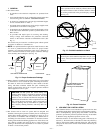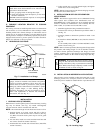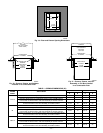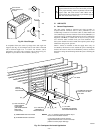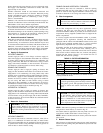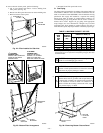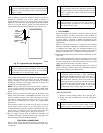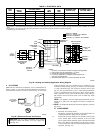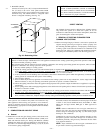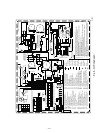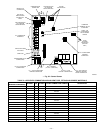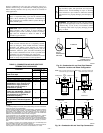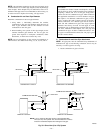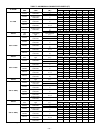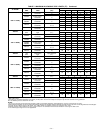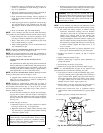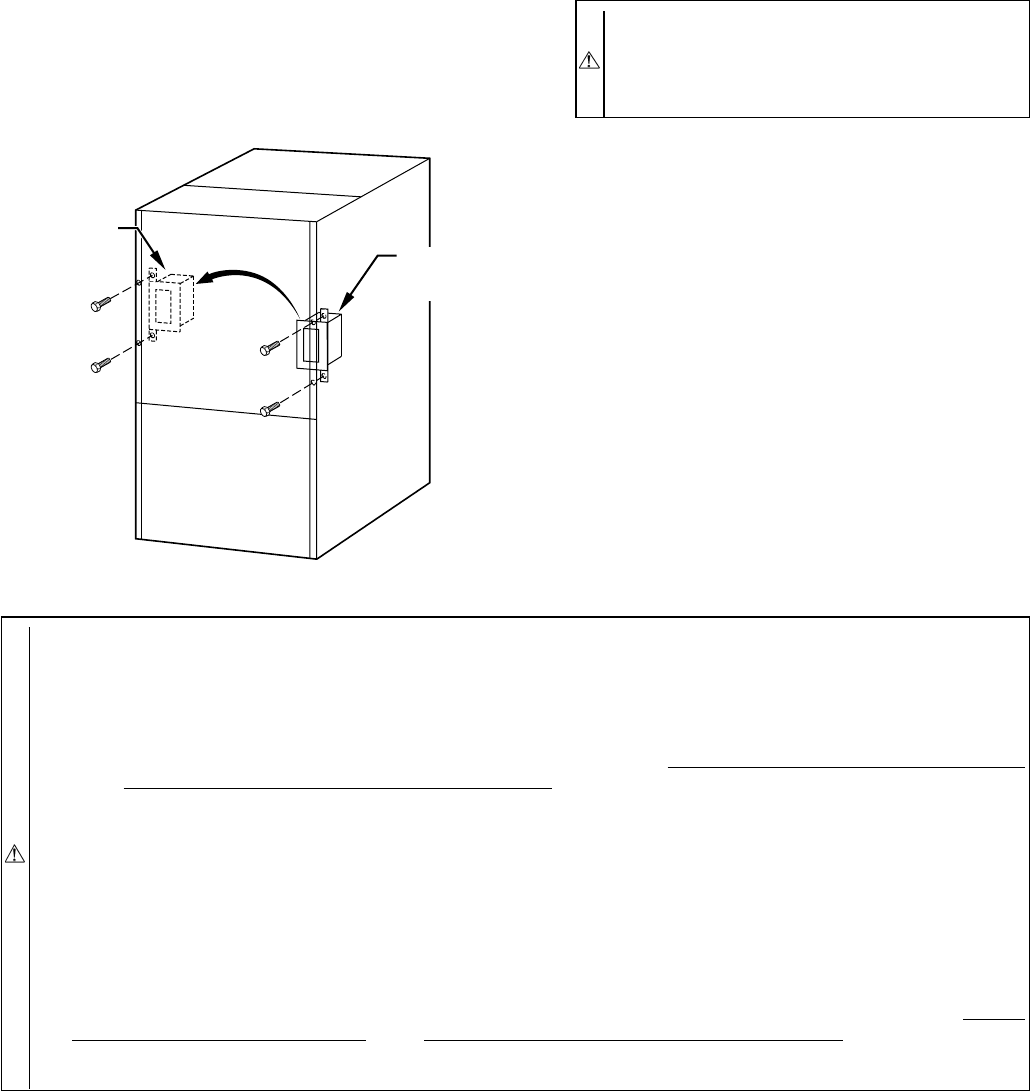
2. Humidifier (HUM)
Connect an accessory 24 VAC, 0.5 amp maximum humidi-
fier (if used) to the 1/4-in. male quick-connect HUM
terminal and C
OM-24V screw terminal on the control board
thermostat strip. The HUM terminal is energized when
blower is energized in heating. (See Fig. 32.)
WARNING: DO NOT connect furnace control HUM
terminal to HUM (humidifier) terminal on Thermidis-
tat™, Zone Controller or similar device. See Thermidis-
tat™, Zone Controller, thermostat, or controller manufac-
turer’s instructions for proper connection.
DIRECT VENTING
The 355MAV furnaces require a dedicated (one 355MAV furnace
only) direct-vent system. In a direct-vent system, all air for
combustion is taken directly from outdoor atmosphere, and all flue
gases are discharged to outdoor atmosphere.
I. REMOVAL OF EXISTING FURNACES FROM
COMMON VENT SYSTEMS
When an existing Category I furnace is removed or replaced, the
original venting system may no longer be sized to properly vent
the remaining attached appliances. An improperly sized Category
I venting system could cause the formation of condensate in the
furnace and vent, leakage of condensate and combustion products,
and spillage of combustion products into the living space, etc.
WARNING: CARBON MONOXIDE POISONING HAZARD
Failure to follow the steps outlined below for each appliance connected to the venting system being placed into operation could result
in carbon monoxide poisoning or death.
The following steps shall be followed for each appliance connected to the venting system being placed into operation, while all other
appliances connected to the venting system are not in operation:
1. Seal any unused openings in venting system.
2. Inspect the venting system for proper size and horizontal pitch, as required in the National Fuel Gas Code, ANSI Z223.1/NFPA 54
or the CSA B149.1, Natural Gas and Propane Installation Code and these instructions. Determine that there is no blockage or
restriction, leakage, corrosion and other deficiencies, which could cause an unsafe condition.
3. As far as practical, close all building doors and windows and all doors between the space in which the appliance(s) connected to the
venting system are located and other spaces of the building.
4. Close fireplace dampers.
5. Turn on clothes dryers and any appliance not connected to the venting system. Turn on any exhaust fans, such as range hoods and
bathroom exhausts, so they are operating at maximum speed. Do not operate a summer exhaust fan.
6. Follow the lighting instructions. Place the appliance being inspected into operation. Adjust the thermostat so appliance is operating
continuously.
7. Test for spillage from draft hood equipped appliances at the draft hood relief opening after 5 minutes of main burner operation. Use
the flame of a match or candle.
8. If improper venting is observed during any of the above tests, the venting system must be corrected in accordance with the National
Fuel Gas Code, ANSI Z223.1/NFPA 54 and/or CSA B149.1, Natural Gas and Propane Installation Code.
9. After it has been determined that each appliance connected to the venting system properly vents when tested as outlined above, return
doors, windows, exhaust fans, fireplace dampers and any other gas-fired burning appliance to their previous conditions of use.
Vent system or vent connectors may need to be resized. For any
other appliances when resizing vent systems or vent connectors,
system or connector must be sized to approach minimum size as
determined using appropriate vent sizing table found in the NFGC
or NSCNGPIC.
II. COMBUSTION-AIR AND VENT PIPING
A. General
Combustion-air and vent pipe, fittings, primers, and solvents must
conform to American National Standards Institute (ANSI) stan-
dards and American Society for Testing and Materials (ASTM)
standards. See Table 5 for approved materials for use in the U.S.A.
See Table 7 for maximum pipe lengths and Fig. 37, 38, 39, 40, and
41 for exterior piping arrangements.
In Canada, construct all combustion-air and vent pipes for this unit
of CSA or ULC listed schedule-40 PVC, PVC-DWV or ABS-
DWV pipe and pipe cement. SDR pipe is NOT approved in
Canada.
NOTE: Furnace combustion-air and vent pipe connections are
sized for 2-in. pipe. Any pipe size change should be made outside
furnace casing in vertical pipe. (See Fig. 33.) This allows proper
drainage of vent condensate.
Combustion-air and vent pipes must terminate together in same
atmospheric pressure zone, either through roof or sidewall (roof
termination preferred), using accessory termination kit. See Table
5 for required clearances.
NOTE: Slope combustion-air and vent pipes a minimum of 1/4
in. per linear ft with no sags between hangers.
Fig. 30—Relocating J-Box
A00212
FACTORY
INSTALLED
LOCATION
ALTERNATE
FIELD
LOCATION
—21—
→
→
→



